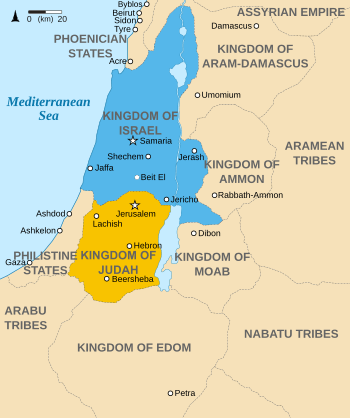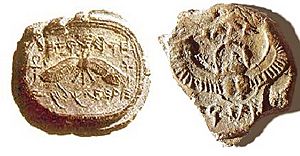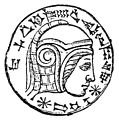Kingdom of Judah facts for kids
Quick facts for kids
Kingdom of Judah
𐤄𐤃𐤅𐤄𐤉
|
|||||||||||
|---|---|---|---|---|---|---|---|---|---|---|---|
| c. 930 BCE–c. 587 BCE | |||||||||||

Map of the region in the 9th century BCE, with Judah in yellow and Israel in blue
|
|||||||||||
| Status | Kingdom | ||||||||||
| Capital | Jerusalem | ||||||||||
| Common languages | Biblical Hebrew | ||||||||||
| Religion | Yahwism/early Judaism Canaanite polytheism Folk religion |
||||||||||
| Demonym(s) | Judahite | ||||||||||
| Government | Monarchy | ||||||||||
| King | |||||||||||
|
• c. 931–913 BCE
|
Rehoboam (first) | ||||||||||
|
• c. 597–587 BCE
|
Zedekiah (last) | ||||||||||
| Historical era | Iron Age | ||||||||||
|
• Jeroboam's Revolt
|
c. 930 BCE | ||||||||||
|
• Siege of Jerusalem
|
c. 587 BCE | ||||||||||
|
|||||||||||
| Today part of | |||||||||||
The Kingdom of Judah (Hebrew: יְהוּדָה, Yəhūdā; Akkadian: 𒅀𒌑DA𒀀𒀀 Ya'údâ; Imperial Aramaic: 𐤁𐤉𐤕𐤃𐤅𐤃 Bēyt Dāwīḏ, "House of David") was an ancient kingdom of the Israelites in the Southern Levant. This area is now part of the Middle East. Its main city and capital was Jerusalem. Another Israelite kingdom, called the Kingdom of Israel, was located to the north. Most Jews today are named after and are descendants of the people from the Kingdom of Judah.
The Hebrew Bible tells us that the Kingdom of Judah was formed after the United Kingdom of Israel split. This united kingdom was supposedly ruled by kings like Saul, David, and Solomon. However, some historians and archaeologists believe that there isn't enough strong proof for a very large kingdom before the late 700s BCE. The Tel Dan Stele, found in 1993, does show that a kingdom, possibly Judah, existed by the mid-800s BCE.
In the 900s and early 800s BCE, the land of Judah seemed to have few people. It mostly had small, unprotected farming villages. But in the 600s BCE, the population grew a lot. The kingdom became rich while it was a vassal (a state controlled by a more powerful one) of the Assyrian Empire. This happened even though King Hezekiah rebelled against the Assyrians.
After the Assyrian Empire fell in 605 BCE, two other empires, Egypt and the Neo-Babylonian Empire, fought for control of the Levant. This caused Judah to decline quickly. In the early 500s BCE, Judah was attacked several times by the Babylonians. In 587 or 586 BCE, Jerusalem was attacked and destroyed by the Babylonian king, Nebuchadnezzar II. He then sent many Judeans away to Babylon. The kingdom became a Babylonian province called Yehud.
Later, the Persian king Cyrus the Great allowed the Jews who had been sent away to return to Judah. They were allowed to govern themselves under Persian rule. The Jews became fully independent again about 400 years later, after the Maccabean Revolt.
Contents
How the Kingdom of Judah Began
The Split of the United Monarchy
The Bible says that the United Kingdom of Israel was started by King Saul around 1000 BCE. It became very strong under kings David and Solomon. After Solomon died around 930 BCE, the Israelites gathered to crown his son, Rehoboam.
Before the crowning, the northern tribes, led by Jeroboam, asked the new king to lower the high taxes and work demands that Solomon had put on them. Rehoboam refused their request. He said he would make their burdens even heavier. Because of this, ten of the tribes rebelled against Rehoboam. They made Jeroboam their king, forming the northern Kingdom of Israel.
At first, only the tribe of Judah stayed loyal to King Rehoboam. But soon, the tribe of Benjamin also joined Judah. These two kingdoms, Judah in the south and Israel in the north, existed side-by-side. They often had conflicts until the Kingdom of Israel was destroyed by Assyria in 722 or 721 BCE.
Judah's Relationship with Israel

For the first 60 years, the kings of Judah tried to regain control over Israel. There was constant fighting between them. King Rehoboam ruled Judah for 17 years, and during this time, Judah and Israel were at war. Rehoboam built strong defenses and fortified cities.
In Rehoboam's fifth year, Shishak, the pharaoh of Egypt, attacked Judah with a large army. He captured many cities. During the attack on Jerusalem, Rehoboam gave all the treasures from the temple to Shishak as a payment. Judah then became a state controlled by Egypt.
Rehoboam's son, Abijah of Judah, continued his father's efforts to control Israel. He fought a big battle against Jeroboam of Israel and won. The Bible says that 500,000 Israelite soldiers died. After this, Jeroboam was not a big threat to Judah for the rest of his rule.
Abijah's son, Asa of Judah, kept peace for the first 35 years of his reign. He improved the fortresses that his grandfather, Rehoboam, had built. The Bible says that Asa's army defeated a huge army led by an Egyptian-backed leader named Zerah the Ethiopian. This victory kept Judah safe from Egyptian attacks for many centuries.
In his 36th year, Asa faced Baasha of Israel, who built a fortress very close to Jerusalem. Asa took gold and silver from the Temple and sent them to the king of Aram-Damascus. In return, the Damascene king broke his peace treaty with Baasha and attacked Israel. Baasha had to leave his fortress. Asa then used the materials from that fortress to strengthen his own cities, Geba and Mizpah in Benjamin.
Asa's successor, Jehoshaphat, changed Judah's policy towards Israel. He decided to form alliances and work with the northern kingdom. He made an alliance with Ahab of Israel through marriage. This alliance led to a disaster for Judah in a battle. Jehoshaphat also tried to trade by sea with Ophir with the help of Ahaziah of Israel, but their ships were wrecked. He later joined Jehoram of Israel in a war against the Moabites, which they won.
Jehoshaphat's son, Jehoram of Judah, also allied with Israel by marrying Athaliah, the daughter of Ahab. Even with this alliance, Jehoram's rule was difficult. Edom rebelled and became independent. A raid by Philistines, Arabs, and Ethiopians looted the king's palace. They took all his family except for his youngest son, Ahaziah of Judah.
Judah's Struggles with Empires
When Hezekiah became the sole ruler around 715 BCE, he made alliances with other cities and Egypt. He then challenged Assyria by refusing to pay tribute. In response, Sennacherib of Assyria attacked Judah's fortified cities. Hezekiah paid a large amount of silver and gold to Assyria. This meant he had to empty the temple and royal treasury. However, Sennacherib still attacked Jerusalem in 701 BCE, but the city was never captured.
During the long rule of Manasseh (around 687/686 – 643/642 BCE), Judah was a vassal of the Assyrian kings. Manasseh had to provide materials for Assyrian building projects and helped in their wars.
When Josiah became king of Judah around 641/640 BCE, the world was changing. The Neo-Assyrian Empire was falling apart, and the Neo-Babylonian Empire had not yet become powerful. Egypt was also recovering from Assyrian rule. In this power vacuum, Judah could rule itself without outside interference.
However, in 609 BCE, Pharaoh Necho II led a large Egyptian army to help the Assyrians. He marched through the coastal areas of Syria. But the Judean army, led by Josiah, blocked his path at Megiddo. A fierce battle was fought, and Josiah was killed. Necho then joined the Assyrians, but they failed to capture a city called Harran. This event also marked the end of the Assyrian Empire.
On his way back to Egypt in 608 BCE, Necho found that Jehoahaz had become king after Josiah. Necho removed Jehoahaz, who had only ruled for three months. He replaced him with Jehoahaz's older brother, Jehoiakim. Necho made Judah pay a heavy tax of silver and gold. He then took Jehoahaz to Egypt as a prisoner.
Jehoiakim first ruled as a vassal of the Egyptians, paying them a lot of money. But when the Egyptians were defeated by the Babylonians in 605 BCE, Jehoiakim switched his loyalty to Nebuchadnezzar II of Babylon. In 601 BCE, Nebuchadnezzar tried to invade Egypt but was pushed back. This failure led to many states, including Judah, rebelling against Babylon. Jehoiakim stopped paying tribute to Nebuchadnezzar and sided with Egypt.
Nebuchadnezzar soon dealt with these rebellions. In 599 BCE, he attacked the region and attacked Jerusalem. Jehoiakim died in 598 BCE during the attack. His son Jeconiah became king. The city fell about three months later, in March 597 BCE. Nebuchadnezzar looted Jerusalem and the Temple, taking all the treasures to Babylon. Jeconiah, his court, important citizens, and skilled workers—about 10,000 people—were sent away from Judah and spread across the Babylonian Empire. The prophet Ezekiel was among them. Nebuchadnezzar then made Zedekiah, Jehoiakim's brother, the new king of the smaller kingdom. Zedekiah had to pay tribute to Babylon.
The Fall of Judah

Even though the prophet Jeremiah warned him, Zedekiah rebelled against Nebuchadnezzar. He stopped paying tribute and made an alliance with Pharaoh Hophra of Egypt. In 589 BCE, Nebuchadnezzar II returned to Judah and again attacked Jerusalem. Many Jews fled to nearby countries like Moab, Ammon, and Edom to find safety.
The city of Jerusalem fell after a long attack, which lasted about a year and a half. Nebuchadnezzar again looted Jerusalem and the Temple, and then destroyed both. After killing all of Zedekiah's sons, Nebuchadnezzar took Zedekiah to Babylon. This was the end of the independent Kingdom of Judah.
According to the Book of Jeremiah, about 4,600 people were sent away after Judah fell. By 586 BCE, much of Judah was ruined. The former kingdom had lost a lot of its wealth and people.
What Happened After Judah Fell
Judah Under Babylonian Rule
Jerusalem seemed to be empty for much of the 500s BCE. The main center of activity moved to Benjamin, the northern part of the kingdom that was not as damaged. The town of Mizpah became the capital of the new Babylonian province called Yehud. This was for the remaining Jewish people in the area. This was a common practice for the Babylonians.
Gedaliah was appointed governor of the Yehud province, with Babylonian soldiers to support him. When other Judeans who had fled to nearby countries heard about this, many returned to Judah. However, Gedaliah was soon killed by a member of the royal family. The remaining people, fearing Babylonian revenge, fled to Egypt. The prophet Jeremiah went with them.
Exile to Babylon
The exact number of people sent to Babylon, those who went to Egypt, and those who stayed in Judah is debated by historians. The Book of Jeremiah says 4,600 people were exiled to Babylonia. The Books of Kings suggest it was 10,000, and later 8,000.
Judah Under Persian Rule
In 539 BCE, the Persian Empire conquered Babylonia. The Persians allowed the exiled Jews to return to Yehud Medinata and rebuild the Temple. The Temple was finished in 515 BCE under Zerubbabel, who was a grandson of one of Judah's last kings. Yehud Medinata was a peaceful part of the Persian Empire until it fell around 333 BCE to Alexander the Great.
Religion in Ancient Judah
The Hebrew Bible often talks about how loyal Judah, especially its kings, were to Yahweh, who is said to be the God of Israel. The Bible says that many kings of Israel and Judah were "bad" because they did not make everyone worship only one God.
Some "good" kings, like Hezekiah (727–698 BCE), tried to stop the worship of other gods like Baal and Asherah. But his successors, Manasseh of Judah (698–642 BCE) and Amon (642–640 BCE), brought back the worship of these other gods. The Bible says this made Yahweh angry. King Josiah (640–609 BCE) tried to bring back the worship of Yahweh alone. However, the Bible suggests his efforts were too late, and Judah's unfaithfulness led to its destruction by the Neo-Babylonian Empire in 587/586 BCE.
However, many modern scholars believe that the Books of Kings might not fully show all the religious beliefs in Judah and Israel during that time.
Archaeological Discoveries
How the Kingdom of Judah formed is a big topic of discussion among experts. There are different ideas about it.
While it is generally agreed that the stories of David and Solomon from the 900s BCE don't tell us much about Judah's beginnings, there's no agreement on whether Judah grew out of the United Kingdom of Israel (as the Bible says) or developed on its own. Some scholars think that Jerusalem, Judah's capital, didn't become a major city until the late 700s BCE. Before that, archaeological finds suggest its population was too small to support a strong kingdom.

The Tel Dan Stele shows that a historical "House of David" ruled a kingdom south of Samaria in the 800s BCE. Evidence of several Judean kings from the 700s BCE has also been found. However, these findings don't fully show how developed the kingdom actually was. The Nimrud Tablet K.3751, from around 733 BCE, is the earliest known record of the name "Judah" (written in Assyrian cuneiform as Ya'uda).
The importance of Jerusalem in the 900s BCE is a big debate. The oldest part of Jerusalem, the City of David, doesn't show much evidence of Israelite homes until the 800s BCE. However, unique structures like the Stepped Stone Structure and the Large Stone Structure contain older materials. Some scholars argue that Jerusalem was just a small village then. Others believe it was a small town with a strong fortress, which could have been the center of a regional power.
A collection of military orders found in the ruins of a military fortress in the Negev desert, from the time of the Kingdom of Judah, shows that many people could read and write. This suggests that literacy was common throughout the military, from commanders to lower-ranking officers. This indicates that Judah had a good educational system at that time.
LMLK Seals
LMLK seals are ancient Hebrew stamps found on the handles of large storage jars. They date back to the time of King Hezekiah (around 700 BCE) and were mostly found near Jerusalem. Several complete jars were found buried under a layer of destruction caused by Sennacherib at Lachish. No original seals have been found, but about 2,000 impressions from at least 21 different seal types have been studied.
LMLK stands for the Hebrew letters lamedh mem lamedh kaph (pronounced lamelekh). This can be translated as:
- "[belonging] to the king" [of Judah]
- "[belonging] to King" (a person or god's name)
- "[belonging] to the government" [of Judah]
- "[to be sent] to the King"
Daily Life in Judah
A 2022 study found traces of vanilla in wine jars in Jerusalem. This suggests that the wealthy people of Judah enjoyed wine flavored with vanilla during the 600s and 500s BCE. Until recently, vanilla was not thought to be available in the ancient Old World. Archaeologists believe this discovery might be linked to an international trade route that crossed the Negev desert during that period, possibly under Assyrian and later, Egyptian rule.
Images for kids
-
A depiction of Nebuchadnezzar II, the Babylonian king who conquered Judah.
See also
 In Spanish: Reino de Judá para niños
In Spanish: Reino de Judá para niños









